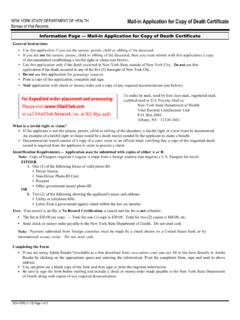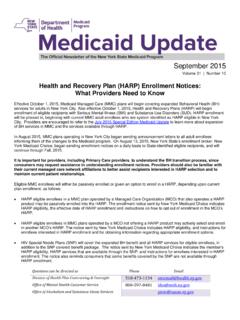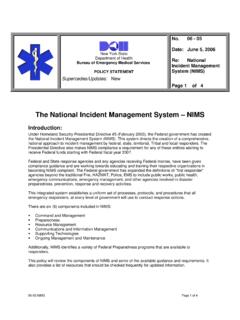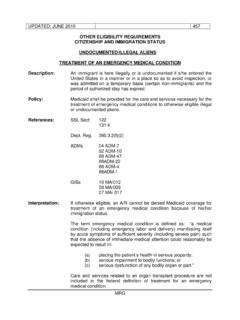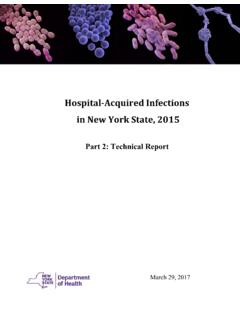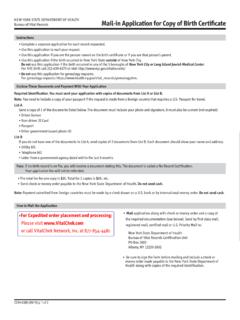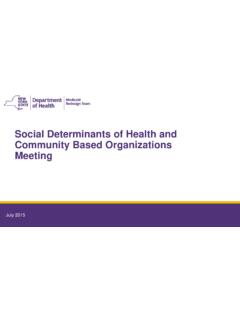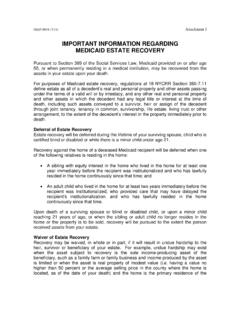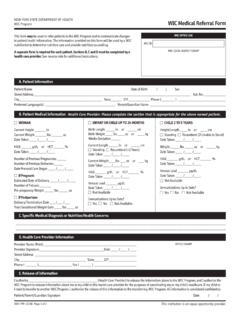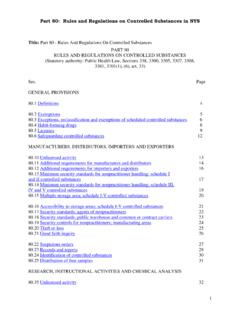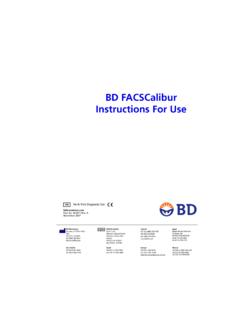Transcription of Use with separate Hospital and Community PRI Instructions
1 DOH-694 (12/05) Page 1 of 4 NEW york STATE department OF HEALTHOHSM-Division of Quality and Surveillance for Nursing Homes and ICFs/MR Use with separate Hospital and Community PRI InstructionsI. ADMINISTRATIVE DATA1. OPERATING CERTIFICATE NUMBER(1-8) 2. SOCIAL SECURITY NUMBER(9-17) - - 3. OFFICIAL NAME OF Hospital OR OTHER AGENCY/FACILITY COMPLETING THIS REVIEW 4A. PATIENT NAME (AND Community ADDRESS IF REVIEWED INCOMMUNITY) 4 B.
2 C O U N T Y O F R E S I D E N C E 11A. DATE OF Hospital ADMISSION OR INITIAL AGENCY VISIT (49-56) - - MO DAY YEAR5. DATE OF PRI COMPLETION(18-25) - - MO DAY YEAR11B. DATE OF ALTERNATE LEVEL OF CARE STATUS IN Hospital (IF APPLICABLE) (57-64) - - MO DAY YEAR6. MEDICAL RECORD NUMBER/CASE NUMBER(26-34) 12. MEDICAID NUMBER(65-75) 7. Hospital ROOM NUMBER(35-39) 13.
3 MEDICARE NUMBER(76-85) 8. NAME OF Hospital UNIT/DIVISION/BUILDING 14. PRIMARY PAYOR (86) 1=Medicaid2=Medicare3= Other9. DATE OF BIRTH (40-47) - - MO DAY YEAR15. REASON FOR PRI COMPLETION (87) 1. RHCF Application from Hospital2. RHCF Application from Community3. O t h e r ( S p e c i f y : )10. SEX (48) 1=Male2=FemaleII. MEDICAL EVENTS16. DECUBITUS LEVEL: ENTER THE MOST SEVERELEVEL (0-5) AS DEFINED IN THE Instructions .
4 18. MEDICAL TREATEMENTS: READ THE Instructions FORTHE QUALIFIERS. 1=YES 2=NO17. MEDICAL CONDITIONS: DURING THE PAST WEEK. READ THEINSTRUCTIONS FOR SPECIFIC DEFINITIONS1=YES 2=NOA. Trachesotomy Care/Suctioning(Daily Exclude self-care) A. Comatose B. Suctioning-General (Daily) B. Dehydration C. Oxygen (Daily) C. Internal Bleeding D. Respiratory Care (Daily) D. Stasis Ulcer E. Nasal Gastric Feeding E. Terminally Ill F. Parenteral Feeding F. Contractures G. Wound Care G. Diabetes Mellitus H. Chemotherapy H. Urinary Tract Infection I. Transfusion I. HIV Infection Symptomatic J. Dialysis J. Accident K. Bowel and Bladder Rehabilitation (SEE Instructions ) K. Ventilator Dependent L. Catheter (Indwelling or External) M.
5 Physical Restraints (Daytime Only) RUG II Group (print name)RHCF Level of Care: HRF SNFH ospital and CommunityPatient Review Instrument (HC-PRI)DOH-694 (12/05) Page 2 of 4 III. ACTIVITIES OF DAILY LIVING (ADLs)Measure the capability of the patient to perform each ADL 60% or more of the time it is performed during the past week (7 days). Read theInstructions for the Changed Condition Rule and the definitions of the ADL EATING: PROCESS OF GETTING FOOD BY ANY MEANS FROM THE RECEPTACLE INTO THE BODY (FOR EXAMPLE:PLATE, CUP, TUBE)19. (113)1=Feeds self without supervision or physical assistance. May useadaptive Requires continual help (encouragement/teaching/physical assistance) with eating or meal will not be intermittent supervision (that is, verbalencouragement/guidance) and/or minimal physical assistance withminor parts of eating, such as cutting food, buttering bread oropening milk fed by hand, patient does not manually participate5=Tube or parenteral feeding for primary intake of food.
6 (Not just forsupplemental nourishments)20. MOBILITY: HOW THE PATIENT MOVES ABOUT20. (114)1=Walks with no supervision or human assistance. May requiremechanical device (for example, a walker), but not a Walks with constant one-to-one supervision and/or constant with intermittent supervision (that is, verbal cueing andobservation). May require human assistance for difficult parts ofwalking (for example, stairs, ramps).4= Wheels with no supervision or assistance, except for difficult maneuvers(for example, elevators, ramps). May actually be able to walk, but generallydoes not Is wheeled, chairfast or bedfast. Relies on someone else to moveabout, if at TRANSFER: PROCESS OF MOVING BETWEEN POSITIONS, TO/FROM BED, CHAIR, STANDING, (EXCLUDETRANSFERS TO/FROM BATH AND TOILET).
7 21. (115)1=Requires no supervision or physical assistance to completenecessary transfers. May use equipment, such as railings, one person to provide constant guidance, steadiness and/orphysical assistance. Patient may participate in intermittent supervision (that is, verbal cueing, guidance)and/or physical assistance for difficult maneuvers two people to provide constant supervision and/or physically need lifting and is not gotten out of TOILETING: PROCESS OF GETTING TO AND FROM A TOILET (OR USE OF OTHER TOILETING EQUIPMENT, SUCH ASBEDPAN). TRANSFERRING ON AND OFF TOILET, CLEANSING SELF AFTER ELIMINATION AND ADJUSTING (116)1=Requires no supervision or physical assistance. May requirespecial equipment, such as a raised toilet or grab of bowel and bladder.
8 Requires constant supervision and/orphysical assistance with major/all parts of the task, including appliances ( ,colostomy, ileostomy, urinary catheter).2=Requires intermittent supervision for safety or encouragement, orminor physical assistance (for example, clothes adjustment orwashing hands).4=Incontinent of bowel and/or bladder and is not taken to a of bowel and/or bladder, but is taken to a bathroom every twoto four hours during the day and as needed at BEHAVIORS23. VERBAL DISRUPTION: BY YELLING, BAITING, THREATENING, (117)1=No known history2=Known history or occurrences, but not during the past week (7days)4=Unpredictable, recurring verbal disruption at least once during the pastweek (7 days) for no foretold reason3=Short-lived or predictable disruption regardless of frequency (forexample, during specific care routines, such as bathing.)
9 5=Patient is at level #4 above, but does not fulfill the active treatment andassessment qualifiers (in the Instructions )24. PHYSICAL AGGRESSION: ASSAULTIVE OR COMBATIVE TO SELF OR OTHERS with INTENT FOR INJURY. (FOREXAMPLE, HITS SELF, THROWS OBJECTS, PUNCHES, DANGEROUS MANEUVERS with WHEELCHAIR)24. (118)1=No known history or occurrences, but not during the past week (7days).4=Unpredictable, recurring aggression at least once during the past week (7days) for no apparent or foretold reason (that is, not just during specific careroutines or as a reaction to normal stimuli).3=Predictable aggression during specific care routines or as areaction to normal stimuli (for example, bumped into), regardless offrequency. May strike or is at level #4 above, but does not fulfill the active treatment andassessment qualifiers (in the Instructions ).
10 DOH-694 (12/05) Page 3 of 425. DISRUPTIVE, INFANTILE OR SOCIALLY INAPPROPRIATE BEHAVIOR: CHILDISH, REPETITIVE OR ANTISOCIALPHYSICAL BEHAVIOR WHICH CREATES DISRUPTION with OTHERS. (FOR EXAMPLE, CONSTANTLY UNDRESSING SELF,STEALING, SMEARING FECES, SEXUALLY DISPLAYING ONESELF TO OTHERS). EXCLUDE VERBAL ACTIONS. READ THEINSTRUCTIONS FOR OTHER (119)1=No known history2=Displays this behavior, but is not disruptive to others (for example,rocking in place).4=Occurences of this disruptive behavior at least once during the past week(7 days)3=Known history or occurrences, but not during the past week (7days).5=Patient is at level #4 above, but does not fulfill the active treatment andpsychiatric assessment qualifiers (in Instructions ).26. HALLUCINATIONS: EXPERIENCED AT LEAST ONCE DURING THE PAST WEEK.
